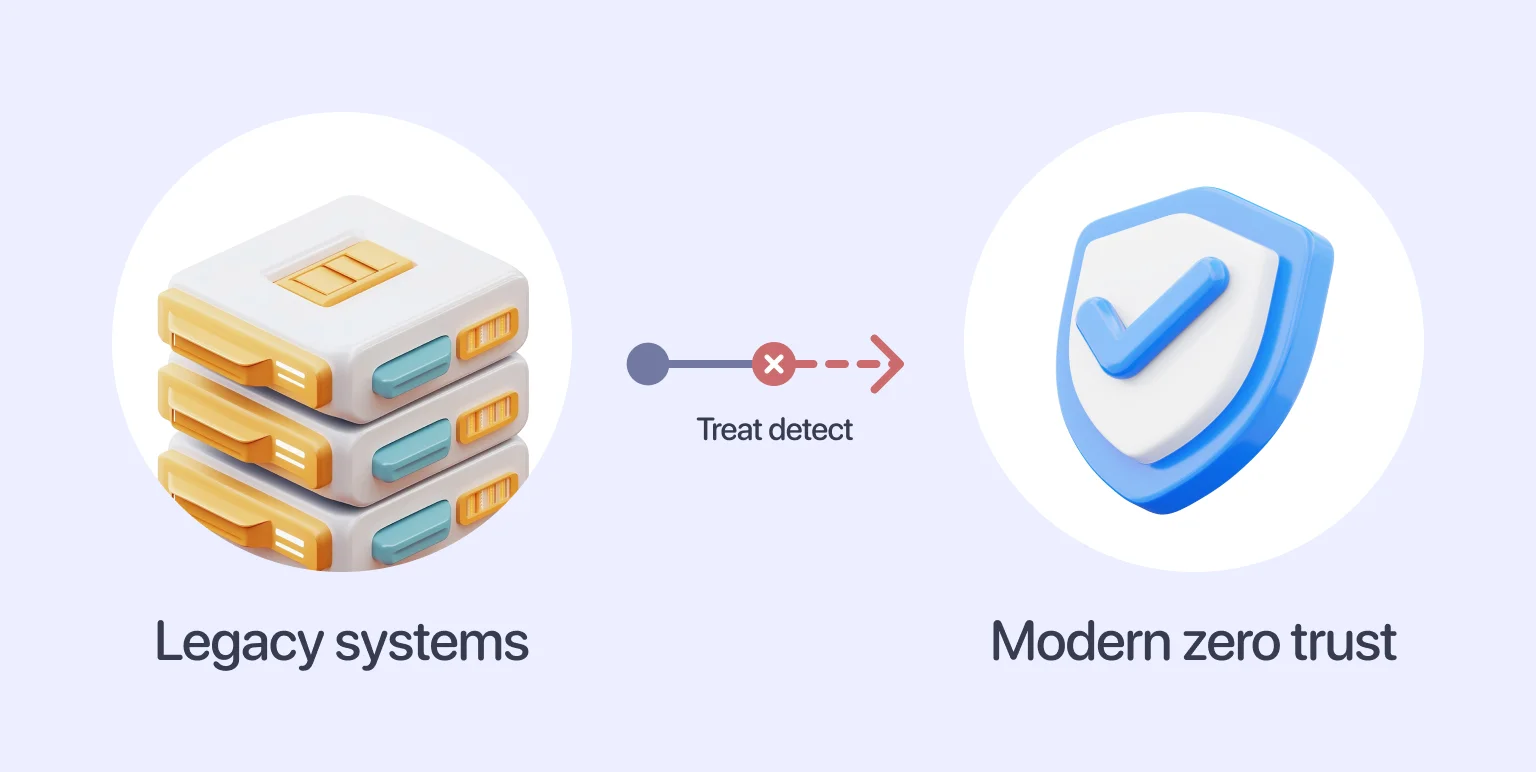Is your organization still relying on legacy systems in healthcare that seem stuck in another decade? You’re not alone. Many providers continue using outdated software because it appears stable, but beneath the surface, these platforms drain budgets, increase security risks, and block innovation. That’s why healthcare software modernization has shifted from being optional to being a strategic necessity.
The challenge is that sticking with old systems may feel safe, yet it’s one of the riskiest decisions an organization can make. Every year you delay, you fall further behind as regulations tighten, cyberattacks grow more frequent, and patients expect fast, digital-first services that outdated platforms can’t deliver. Choosing not to act doesn’t preserve stability, but instead multiplies the risk.
This guide will show you exactly what a legacy system in healthcare is, why holding onto it creates mounting liabilities, and the proven strategies you can use to modernize. By exploring both the challenges and solutions, you’ll see how to design a roadmap that connects short-term improvements with long-term growth, ultimately preparing your organization for AI-driven, cloud-ready, patient-first technologies.
What is a legacy system in healthcare?
The answer to the question posed in the headline is as follows: it is any older software application that remains in use even though better, more modern alternatives exist. These platforms may still function, but they are slow, expensive to maintain, and unable to meet today’s standards for interoperability, compliance, and patient experience.
Defining legacy systems
So now, it’s time to provide a more detailed explanation of the term that has already been mentioned several times. Legacy systems in healthcare usually refer to a platform that is:
- Built on outdated programming languages or frameworks that few developers can still maintain.
- Designed with monolithic architecture, making it hard to scale or adapt.
- Unsupported by its original vendor, leaving organizations without updates or technical help.
- Unable to integrate smoothly with newer systems, creating silos of critical data.
While these platforms may seem reliable, their rigidity blocks innovation and slows down progress. Outdated infrastructure increases costs and risks over time, especially as maintenance becomes more expensive and skilled staff harder to find. In practice, these limitations restrict an organization’s ability to meet rising patient expectations or adopt modern technologies.
Examples & use cases of legacy medical systems
Legacy systems in healthcare are present in nearly every function of a medical organization. They continue to operate in clinical and administrative areas where existing workflows resist technological change, even as performance expectations increase. Let’s examine some examples of these and why they may persist.
Examples of legacy systems
The scope of these entrenched platforms is vast and presents a complex network of interconnected challenges. Some of the most common include:
- Electronic Health/Medical Records (EHR/EMR). Often lacking modern usability and integration features. These platforms may still store essential patient records, but frustrate staff with poor interfaces and limited interoperability.
- Hospital Information Systems (HIS). Handling finances and operations, but unable to provide real-time reporting. This limits an organization’s ability to make fast, data-driven decisions.
- Laboratory Information Systems (LIS). Requiring manual data entry and offering limited connection to modern EHRs often leads to duplication of work and a higher risk of error. This lack of automated information exchange directly slows patient throughput.
- Imaging systems (RIS, PACS). Storing critical scans and reports, but locked in silos, making it hard for departments to collaborate effectively. This departmental isolation results in delayed diagnosis times and redundant imaging procedures.
- Billing and claims software: Struggling to keep up with evolving compliance standards, slowing down reimbursements, and adding administrative pressure. This direct inefficiency leads to increased claim denial rates and diminished revenue capture.
- Middleware: Once a bridge between old and new, now often outdated themselves, sometimes creating more complexity instead of solving it. These inflexible layers introduce significant points of failure and increase total ownership costs.
Why legacy systems persist
If outdated healthcare platforms are so limiting, why do organizations still hold onto them? The reasons usually come down to risk-aversion, regulatory inertia, and cost.
First, there’s fear of downtime. Because these systems are so deeply tied to daily clinical work, leaders avoid replacing them out of concern for disruptions. Second, the cost and complexity of full replacement can feel overwhelming, especially when budgets are already tight. Even when leaders know modernization is necessary, the perceived risk of failure often delays action.
Regulatory inertia also plays a role. As long as an old system technically meets minimum compliance, leaders may see no reason to risk replacing it. Finally, organizational resistance is strong. Staff often prefer the familiarity of existing workflows, even if they are inefficient.
With over 80% of IT budgets in healthcare spent just keeping outdated systems alive, there’s little left for transformation, leaving modernization as a challenge that feels constantly out of reach.
Why is the modernization of healthcare soft so important?
In any industry that is constantly evolving, the permanent updating of systems is an absolute necessity. That’s why the urgency of healthcare software modernization cannot be overstated. Delaying upgrades doesn’t just keep you stuck. Instead, it makes you fall further behind every year. Modernization is critical for four reasons: compliance, security, cost, and innovation.
Regulatory & compliance pressures
Healthcare faces some of the strictest rules of any industry. Outdated systems are not designed to handle these requirements. Regulations like HIPAA and GDPR demand robust data protection, and legacy platforms rarely meet these standards. New rules, including the ONC Cures Act, TEFCA, and USCDI updates, require smooth integration and information exchange. Old systems struggle to comply, putting organizations in jeopardy of audits and penalties.
Security, risk & cyber threats
Cybersecurity is another urgent factor. Healthcare is now one of the top targets for cyberattacks worldwide, with breaches at organizations like UnitedHealth and Ascension making headlines. Old systems are highly vulnerable because they lack updates, encryption, and multi-factor authentication. Moving toward a Zero Trust model, based on least privilege and segmentation, is nearly impossible without modernizing.

Operational efficiency & cost burden
The expenditure on maintaining legacy systems in healthcare is staggering. Most IT budgets are consumed by patching, supporting, and troubleshooting outdated platforms. Performance is also a problem: slow workflows, frequent crashes, and limited automation drag down efficiency. Vendor lock-in makes matters worse, leaving organizations stuck paying high rates for minimal support.
Innovation, interoperability & patient expectations
Finally, modernization is essential for innovation. Without flexible, cloud-ready systems, you can’t fully adopt telehealth, wearables, or AI-driven solutions. Patients now expect easy digital access to appointments, records, and care, but outdated platforms fail to deliver.
“Modern healthcare software unlocks digital-first patient experiences.” {{sergiy-sumnikov}}
Generative AI is already transforming the industry, from predictive diagnostics to smarter resource planning. Without a strong, modern foundation, you risk missing out on these opportunities. For this reason, healthcare software modernization is key — by upgrading legacy systems, you can unlock AI’s potential while keeping compliance and patient trust intact.
For more insights on getting started with artificial intelligence, read our blog on how generative AI works and how to use LLMs wisely.
Warning signs that say: modernize now
If you’re still uncertain whether it’s time to invest in healthcare software upgrading, take a closer look at your current systems. They are likely already sending you clear warning signals. Recognizing these signs early can help avoid bigger problems later. Let’s examine some in more detail.
Performance & usability issues
One of the first red flags is when your software actively slows down care delivery. Frequent downtime, sluggish performance, or clunky, unresponsive interfaces create frustration for staff and patients alike. When doctors and nurses spend more time wrestling with screens than providing care, the system is no longer helping.
You must prioritize design that supports healthcare professionals. For instance, we provide healthcare UI/UX design services focused on creating user-friendly, efficient, and safe digital experiences that reduce burnout and improve patient outcomes.
Data fragmentation & poor interoperability
Another clear warning sign is when patient information is scattered across disconnected platforms. If your team has to re-enter the same data multiple times or manually transfer files between departments, your system is already falling behind.
This duplication not only wastes time but also increases the risk of mistakes. In healthcare, fragmented records can mean misdiagnoses, repeated tests, or delayed treatments. If your systems can’t integrate with new technologies or share information seamlessly across clinical functions, modernization becomes urgent.
Vendor support loss or end-of-life
If your vendor has announced they will no longer service or update your platform, you are essentially operating on borrowed time. Without ongoing patches, bug fixes, or technical assistance, every day you continue using the system increases your exposure to security risks.
Outdated software quickly becomes a target for cyberattacks, especially when vulnerabilities are no longer being patched. Moreover, when technical issues arise, your internal IT team may lack the expertise to solve them without vendor support. End-of-life systems are more than inconvenient. Instead, they are a ticking clock that leaves organizations vulnerable to breaches, downtime, and compliance failures.
Escalating risk and audit failures
Compliance is a core requirement in healthcare. If your system struggles to pass audits, falls short of HIPAA or GDPR standards, or fails repeated security assessments, these are urgent warning signs. Every failed audit doesn’t just create paperwork, but it also exposes your organization to significant financial penalties, legal liability, and reputational damage that may take years to rebuild.
In many cases, outdated systems simply cannot meet modern compliance rules, no matter how much effort your IT team invests. The longer you wait to modernize, the deeper the regulatory gap grows and the harder it becomes to catch up.
Technology stagnation
When your platforms haven’t evolved in years, you’re missing out on critical innovations that are rapidly shaping modern healthcare. Whether it’s predictive analytics for faster diagnoses, AI integration for smarter treatment planning, or simply compatibility with modern devices, outdated systems act as roadblocks.
They prevent your staff from working efficiently and limit your ability to deliver a digital-first patient experience. Stagnation slows down your entire organization, from operations to clinical care. Ultimately, relying on technology that has stopped evolving holds you back from providing the high-quality, data-driven healthcare your patients now expect.
Approaches to healthcare software modernization
Modernizing your systems isn’t a one-size-fits-all project. Because every organization has unique goals, budgets, and risk levels, different approaches are available. Each comes with its own balance of speed, cost, and impact, which we detail below.
Rehosting
Rehosting, often known as “lift and shift,” involves moving your existing platform from on-premises infrastructure to the cloud without altering its core code. This method is fast and cost-effective, giving you immediate benefits like better scalability, lower hardware costs, and stronger disaster recovery.
However, rehosting doesn’t fix the underlying problems of the software. It simply moves technical debt to a new environment. It’s a smart choice when you need a quick win or when infrastructure costs are spiraling, but it’s rarely a long-term solution.
Replatforming / encapsulation / API wrapping
Replatforming goes a step further. Here, you make small adjustments to your software so it can take advantage of cloud-native features, like automated backups or scalable databases. This reduces maintenance costs and improves reliability.
Encapsulation, also known as API wrapping, is another practical strategy. By wrapping your legacy system in modern APIs, you allow it to connect with new solutions without changing the internal code. This approach is often used in healthcare to connect outdated EHRs with modern telehealth platforms or patient portals.
The strength of this approach is that it delivers interoperability without requiring a complete rewrite, making it a safer middle ground between temporary fixes and full replacement.
Refactoring / restructuring
Refactoring is like cleaning up the inside of your house without tearing it down. You rework parts of the code to improve performance, scalability, and maintainability while keeping the same overall functionality.
For healthcare, this approach works best when your system provides valuable features but can’t keep up with modern demands. By restructuring the internal architecture, you break apart rigid monolithic code into smaller, modular components that are easier to manage and update.
Rebuilding / re-architecting
When a system is beyond saving, rebuilding is the only option. This means starting from scratch and creating a new platform using modern frameworks. While resource-intensive, it allows you to design an adaptable system from the ground up.
Re-architecting is similar but focuses on redesigning the platform’s structure, often moving from a monolithic approach to microservices. This is ideal for hospitals looking to expand telehealth or integrate AI-powered diagnostics. It’s the most disruptive option, but also the one that provides the most long-term flexibility.
Hybrid & incremental approaches
In reality, most organizations take a hybrid route. They might rehost some systems for quick wins, refactor others for performance, and rebuild the most critical applications. This incremental approach spreads out costs, reduces disruption, and creates a balanced path toward full modernization.
Such a phased methodology allows clinical staff to quickly adopt updated functionalities without overwhelming system-wide training. It ensures that essential patient care systems remain operational and compliant throughout the transition. The incremental gains immediately improve data security and streamline interoperability between core clinical platforms. This targeted strategy prioritizes patient safety and accelerates compliance within the regulatory framework.
Middleware & API-centric integration
Middleware plays a key role in bridging the gap between legacy systems in healthcare and modern applications. By allowing data to flow between platforms, middleware reduces silos and improves efficiency.
Modern API-centric integration takes this further. Using standards like FHIR and USCDI, APIs allow new and old systems to communicate seamlessly. This ensures that modernization can happen gradually, without leaving behind critical patient information.
You must adopt modern, API-driven development to ensure interoperability, security, and long-term scalability. To tackle these issues, we provide healthcare software development services that deliver tailored solutions that connect your legacy systems with modern platforms so that you can innovate without disruption.

Challenges & risks during modernization
While the benefits of healthcare software modernization are clear, the process comes with difficulties you must anticipate. The key is to manage these risks proactively. Here’s what you should know and how to respond proactively.
Clinical disruption & downtime risk
One of the biggest concerns is disruption to patient care. Because systems are deeply embedded in daily operations, even small errors can cause downtime. The best way to reduce this risk is by phasing your modernization, starting with non-critical platforms and expanding gradually.
Data migration errors
Migrating decades of patient information is complex. Without proper planning, you risk corruption, duplication, or loss. Specialized migration tools, strong governance, and constant testing are necessary to keep your data accurate and secure.
Resistance from users & workflow misalignment
Even the best software fails if staff won’t use it. Doctors and nurses often resist new platforms because they’re comfortable with the old ones. Comprehensive training, clear communication, and involving users early are essential for success.
Compliance risks in transition
Healthcare is heavily regulated, so compliance must remain a top priority throughout modernization. Each phase should undergo security audits and parallel testing to ensure the new system meets HIPAA, GDPR, and other standards before the old one is retired.
Budget overruns, delays & scope creep
Large projects often exceed initial estimates. To prevent overruns, you need a clear roadmap, well-defined goals, and contingency planning for unexpected issues. Incremental modernization also helps spread costs over time.
Technical debt & legacy interdependencies
Legacy systems often hide complex dependencies. You may not discover these until the modernization process is underway. A detailed assessment phase is critical to map these interconnections and avoid failures during migration.
Step-by-step modernization roadmap
Upgrading legacy systems in healthcare is not something you can approach without a clear plan. Because these systems are so deeply connected to daily clinical operations, you need a structured process that reduces risk while maximizing value. We’ve prepared a step-by-step roadmap that helps you modernize without disrupting patient care.
Assessment & discovery
The first step is understanding where you stand today. This involves a complete evaluation of your current systems, identifying weaknesses, compliance gaps, and areas that slow down workflows. A proper discovery phase also maps out technical dependencies and legacy interconnections that may cause trouble later.
Involving stakeholders from across the organization — IT staff, administrators, and clinicians — is a must. Each group sees different problems, and gathering these perspectives ensures your plan addresses real-world challenges.
Define goals, KPIs & success criteria
Once you know where you are, you need to decide where you want to go. Defining goals keeps the modernization process focused and measurable. Are you looking to improve data security, reduce IT costs, or enhance patient satisfaction?
From there, establish clear KPIs (key performance indicators) to measure progress. Examples include:
- Reduced average patient wait times
- Lower readmission rates
- Higher system uptime percentages
- Fewer compliance penalties
- Measurable ROI from modernization investments
By setting these benchmarks early, you can track whether your efforts are actually delivering value.
Target architecture technology stack
Next, you need to decide what your future systems will look like. Will you adopt a microservices model for flexibility? Move fully to the cloud for scalability? Use FHIR APIs to guarantee interoperability?
Your chosen architecture sets the foundation for everything else. It should align with your goals, whether that’s improving patient experience, meeting compliance standards, or enabling AI-driven analytics.
Detailed planning & risk mitigation
This stage turns strategy into execution. A detailed project plan should outline each phase of the modernization, account for technical risks, and define your data migration process.
Planning also includes security considerations. Ensuring HIPAA and GDPR compliance must remain central throughout the project. Conducting trial migrations and penetration tests in advance helps prevent unpleasant surprises.
Implementation & migration
Modernization works best when rolled out in phases. Start with non-critical systems, test them thoroughly, and then move to the core platforms. This incremental approach reduces downtime and allows your team to learn and adapt along the way.
Backup and recovery strategies are crucial. If something fails during migration, you need a way to restore data immediately to avoid service interruptions.

Change management & training
Even the most advanced software won’t succeed if users reject it. Change management ensures that staff understand why modernization is happening and how it benefits their work. Training programs, video tutorials, and help desks can ease the transition.
Ultimately, adoption depends on communication. When staff see how the new system saves them time or reduces frustration, resistance begins to fade.
Post-migration monitoring, security & continuous improvement
Modernization doesn’t stop when the system goes live. Ongoing monitoring ensures that KPIs are met and security stays strong. Regular updates, audits, and continuous improvements are part of keeping the new systems future-ready.
“A modern healthcare system isn’t a one-time investment — it’s a continuous commitment to patient safety and innovation.” {{sergiy-sumnikov}}
Modern tech stack for healthcare systems
Once you modernize, the question becomes: what technologies will support you moving forward? A modern tech stack offers flexibility, scalability, and security that outdated platforms cannot. Selecting the right components is crucial for building future-ready clinical environments. The following technologies and standards represent essential foundations for contemporary healthcare infrastructure.
Cloud, microservices & serverless in healthcare
Moving to the cloud eliminates reliance on costly on-premises hardware while offering on-demand scalability. Combined with microservices architecture, you break away from rigid monolithic systems and create modular applications that can evolve independently. Serverless computing adds further flexibility, letting you scale services instantly as demand changes.
APIs, FHIR R4+, USCDI v5, TEFCA exchange
Interoperability is now a regulatory requirement, not just a convenience. Standards like FHIR R4+ APIs, USCDI v5, and TEFCA make sure your systems can exchange data smoothly and comply with national frameworks for information sharing. By adopting these protocols, your organization can ensure integration with external networks while meeting compliance mandates.
AI & analytics integration
AI is transforming healthcare, from predictive diagnostics to resource optimization. A modernized system must be able to integrate AI and advanced analytics tools. These tools analyze massive amounts of patient data, uncover patterns, and provide clinicians with actionable insights.
Automation is equally valuable. AI can handle repetitive administrative tasks like scheduling or billing, freeing up staff to focus on patient care.
You must bring AI and analytics directly into your healthcare systems to unlock smarter care delivery. If you’re not technically savvy, seek assistance from professionals in AI integration services. We’ll help you embed predictive models, automate workflows, and use real-time insights to improve both patient outcomes and operational efficiency.

Telehealth, remote monitoring & IoT
Modern systems must also support digital-first healthcare. Telehealth platforms, remote monitoring solutions, and IoT wearables are now standard expectations. Patients want to connect with doctors virtually, track conditions through devices, and have those data streams flow directly into their records. Legacy systems can’t keep up with this demand.
Low-code / no-сode & automation tools
Finally, low-code and no-code tools give organizations the ability to build or adjust applications quickly without large development teams. Combined with RPA (Robotic Process Automation), these tools streamline operations, reduce costs, and speed up development.
Case studies
Looking at real-world examples shows just how powerful healthcare software modernization can be. Below, we share our project experiences to demonstrate practical implementation approaches.
Home Medix Project
Home Medix confronted significant accessibility barriers in the durable medical equipment market, where elderly patients and caregivers struggled with complex purchasing processes. Outdated digital interfaces and confusing insurance requirements created frustration for users navigating mobility aids and respiratory devices. These challenges particularly impacted seniors with limited technical literacy and families managing chronic care needs.
Halo Lab delivered comprehensive website design services to transform the platform into a senior-friendly e-commerce experience. The solution featured accessible navigation, clear product presentation, and integrated insurance verification tools. Strategic design choices prioritized high-contrast visuals and intuitive workflows to build trust and reduce purchasing anxiety. This approach helped establish Home Medix as a reliable destination for home medical equipment, supporting the platform’s expansion in the competitive healthcare market.
Nyra Health Project
Nyra Health, a specialist company based in Vienna, required a more intuitive and functional digital system for monitoring neurological recovery in patients. Their existing application was overly complex and inefficient, making it difficult for physicians and therapists to accurately track patient progress and rehabilitation milestones. Halo Lab’s work centered on redesigning the core user experience to make the platform a powerful, accessible tool for medical practitioners overseeing long-term therapeutic routines.
Our development team engineered a new interface focused on data clarity and functional accessibility. This included integrating sophisticated dashboards and progress-tracking visualizations that transformed complex metrics into immediately comprehensible insights. Additionally, a specialized complaint tagging mechanism was introduced to facilitate precise tracking of patient feedback. This comprehensive UX/UI overhaul resulted in demonstrable success, including a 16% uplift in platform engagement and a fortified reputation among clinical specialists utilizing the sophisticated monitoring tools.
Benefits of modernized healthcare systems
When you successfully modernize your platforms, the benefits are widespread. You reduce IT maintenance costs, strengthen compliance, and improve security with up-to-date protections. Patient satisfaction increases thanks to smoother interfaces and faster services.
Modernized software also enables innovation. With integration across departments and external networks, you unlock AI-driven insights, predictive analytics, and proactive care strategies. In the long term, these improvements add up to stronger ROI and more resilient operations.
Cost, ROI & business justification
Of course, modernization requires investment. Justifying this cost means looking at both avoided risks and future gains.
Key cost components include:
- Initial assessment and planning
- Data migration tools and expertise
- Development and implementation of the new system
- Training and change management
- Infrastructure costs (like moving to the cloud)
The ROI of modernization often appears over time. Avoided costs include reduced IT maintenance, fewer compliance fines, and minimized security incidents. Realized gains come from faster workflows, increased patient throughput, and new revenue opportunities like telehealth.
The payback period varies depending on your approach. Rehosting offers quick wins, while rebuilding takes longer but delivers greater long-term value. A phased strategy allows you to spread costs and minimize disruption.
Financial risks like delays or technical surprises can be managed with contingency planning and incremental rollout strategies.
From legacy burden to strategic asset
To sum up, healthcare software modernization is no longer a choice — it’s a necessity. Outdated systems may feel familiar, but they expose you to rising costs, security threats, and compliance risks. By taking a structured approach, you can move from fragile, outdated platforms to resilient, future-ready solutions that improve both operations and patient care.
The future of healthcare depends on flexibility, integration, and innovation. Don’t let legacy technology hold you back. The sooner you begin the modernization process, the faster you unlock a safer, smarter, and more patient-focused future.
in your mind?
Let’s communicate.

Frequently Asked Questions
Is it always necessary to replace my legacy healthcare system?
Not always. Replacement is the most drastic option, usually chosen when a system is beyond repair or can’t meet compliance. In many cases, replatforming or API wrapping extends the life of your platform while adding modern capabilities. This allows you to modernize gradually without halting critical operations.
Can parts of a legacy system stay while modernizing others?
Yes. Many organizations use a hybrid approach, keeping stable components while connecting them with modern solutions through APIs. This lowers risk and disruption. It also spreads costs over time, making modernization more practical and budget-friendly.
How long does healthcare software modernization typically take?
It depends on the scope. Smaller efforts like rehosting may take a few months, while complete rebuilds can last years. A phased approach is common. This method delivers improvements step by step while ensuring continuity in care.
What are the biggest risks and how can they be mitigated?
The biggest risks are clinical disruption and data migration errors. Careful planning, phased rollouts, and testing help reduce these threats. Strong backup systems and staff training also ensure smoother adoption.
How do I maintain regulatory compliance during modernization?
Continuous monitoring and parallel testing keep new systems aligned with HIPAA, GDPR, and other standards. Regular audits and strong data validation are critical. Partnering with experienced IT teams adds another layer of compliance confidence.
What are good indicators that a modernization effort was successful?
Success includes lower IT costs, fewer compliance failures, and faster patient workflows. Improved staff satisfaction and better patient care are also strong signs. Over time, greater system uptime and smoother interoperability confirm long-term value.




















.webp)






